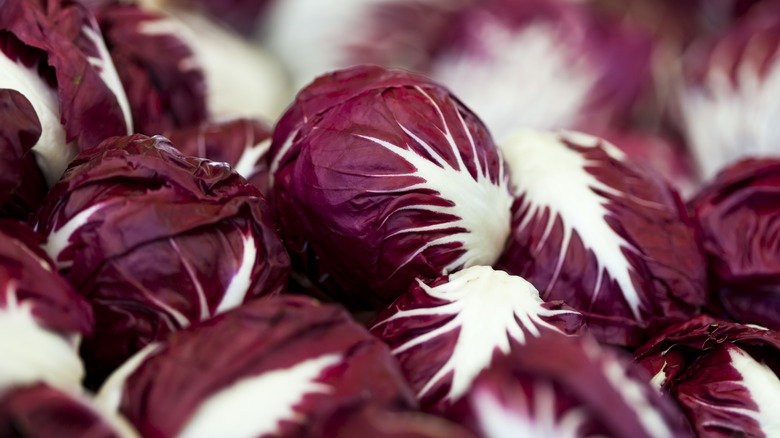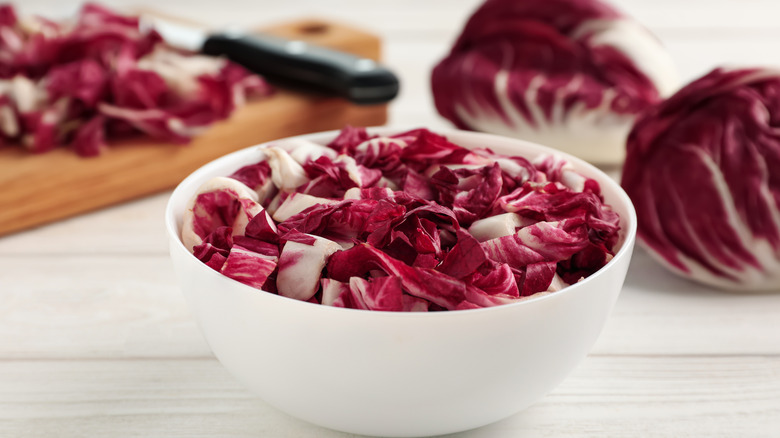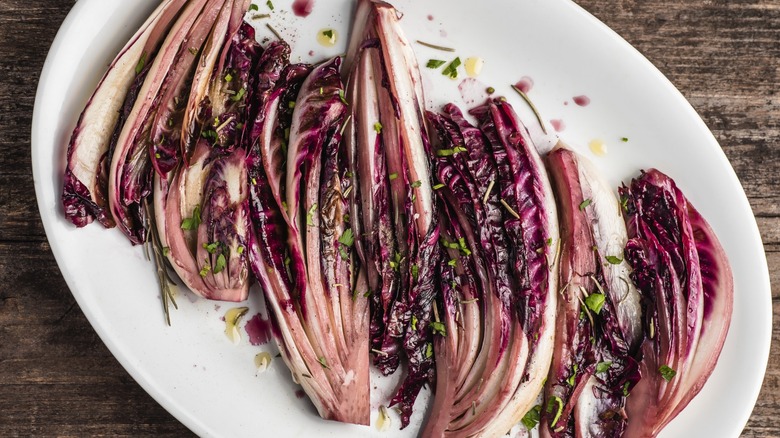How To Take The Bitter Bite Out Of Radicchio
You've probably seen radicchio hanging around your grocery store's produce section, maybe tucked in somewhere between the endive and the escarole. Its rich reddish-purple leaves are streaked with creamy white and coiled into an unusual but eye-catching cone or sphere. Part of the chicory family, radicchio is a winter vegetable that thrives in temperatures that would kill most other edible plants. It's incredibly nutritious, with its vibrant magenta leaves harboring a collection of vitamins and minerals, including vitamin K, which is important to everything from cognitive function to heart and bone health to digestion.
But where radicchio shines is in the kitchen. It can be prepared raw, as part of a winter salad, or cooked on the grill or sauté pan and then folded into pastas or served as an accompaniment to a protein. Radicchio is common in northeastern Italian cuisine, with different varieties cultivated in five specific regions of Veneto, Italy, which have earned Protected Geographical Indications (PGI) status. Despite its health benefits and versatility, however, radicchio might be best known for its bitterness, which can be potent. Taking steps to soften and tame radicchio's sharp bite can accentuate its milder tastes and broaden its applications in your cooking.
How to remove radicchio's bitterness
The source of radicchio's bitterness comes from a chemical compound that is released when the leaves are damaged, cut, or bruised. Therefore, the way you cut the leaves, actually has a significant impact on their ultimate level of bitterness.
For cold or chilled radicchio dishes, you should cut the head in half lengthwise and slice or shred the halves on an angle, a process that helps to make the leaves taste sweeter. Similarly, you can mute the bitterness by thinly slicing the leaves and marinating them in olive oil and salt before serving, or by pairing radicchio with fatty foods, like nuts, oils, or cheeses. Another method is to soak the uncut leaves in cold water for between 10 to 30 minutes. This leaches out a lot of the bitter notes, while giving the leaves a crisp and refreshing taste and texture.
For hot preparations, you can approach removing the bitterness a little differently. Grilling or sautéing radicchio tempers its flavor by releasing the plant's natural sugars. Adding sweetness from another source, whether it be honey, maple syrup, or a balsamic reduction, can also help bring balance and mellow its intensity. A squeeze of citrus also goes a long way in subduing the radicchio's acrid bite.
What to cook with your radicchio
Now that you know how to remove radicchio's bitterness, the next question is: what do you cook with it?
Radicchio's unique flavor profile lends itself to both chilled and warm dishes. As mentioned, it's an excellent addition to salads, with its bold, peppery bite serving as a natural counterpoint to sweet-and-sour dressings, dried and fresh fruits, and soft and hard cheeses. A panzanella salad, which incorporates chunks of toasted bread, as well as an Italian-style antipasti are both great places to slip in some raw or grilled radicchio wedges. You can also combine radicchio with toasty pine nuts and roasted squash or sweet potato for an earthy, savory first course or as a side to a rich entree.
Since radicchio hails from northern Italy, it's a natural fit in a wide range of pasta dishes. Try adding it to recipes with rich and heavy ingredients, like cream, cheeses, intensely seasoned sausages, and cured meats such as pappardelle with radicchio and speck. Similarly, radicchio's bite also does well next to a big protein, like a dry-aged steak, sea bass, or pork chop. Conversely, radicchio's bite can bring taste harmony to the creamy notes of risotto.


